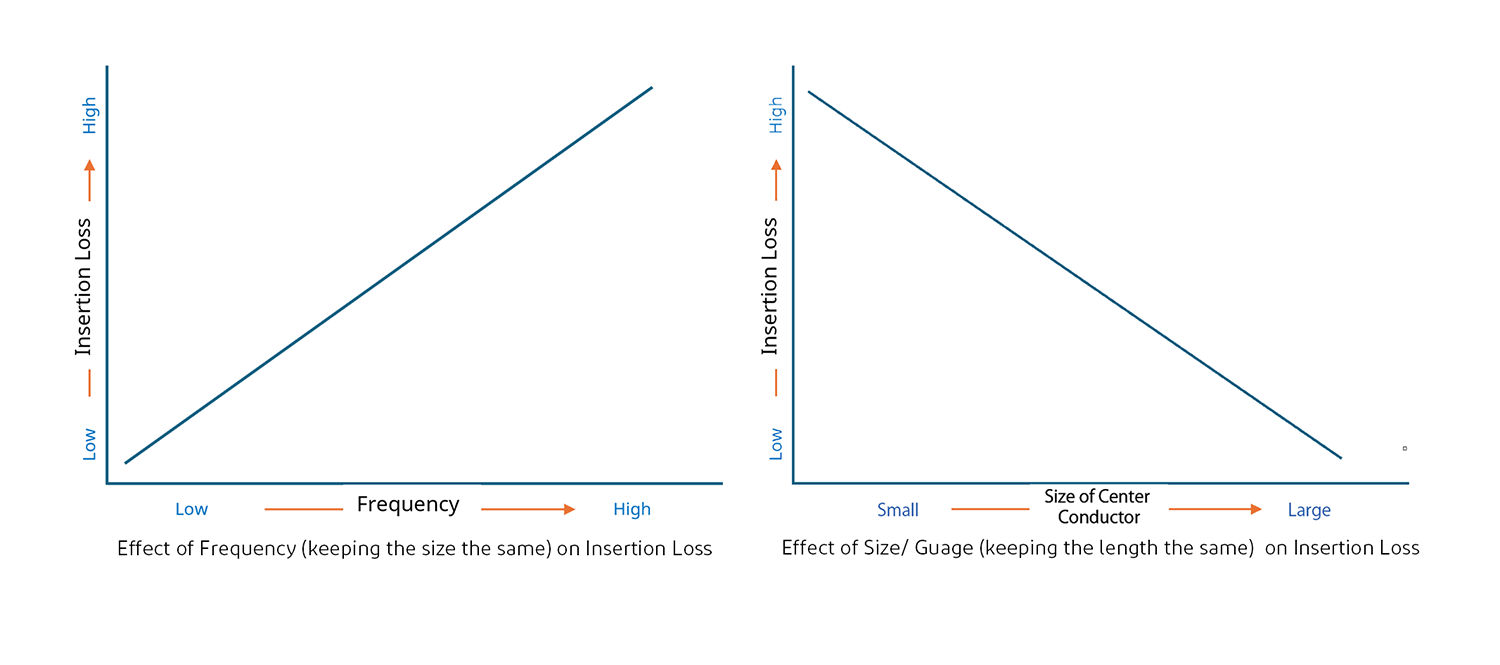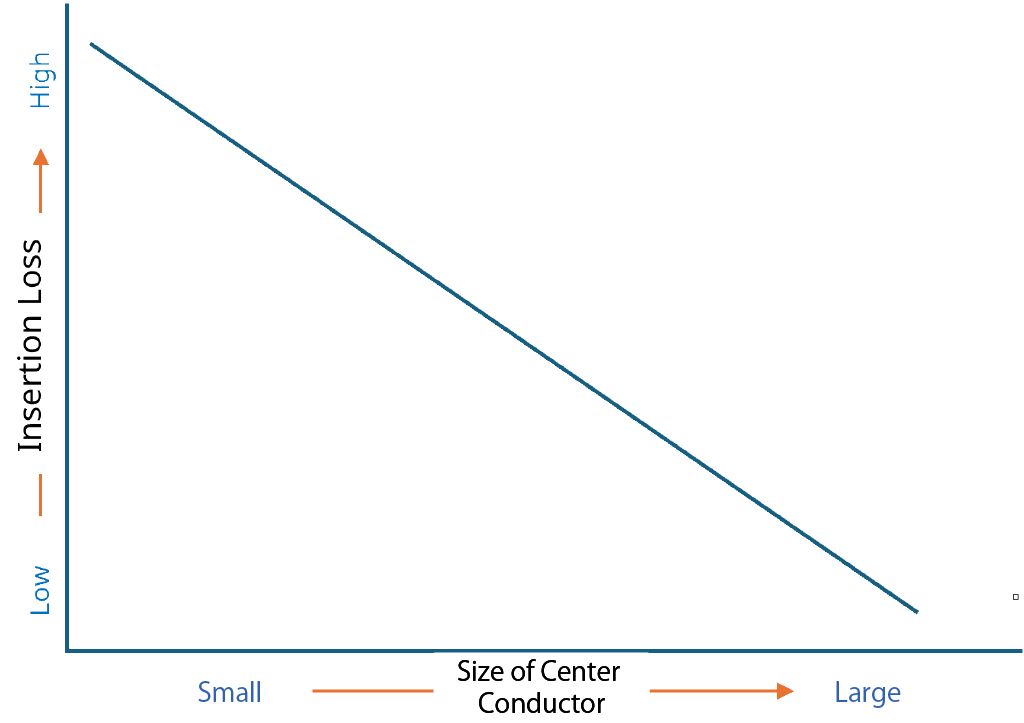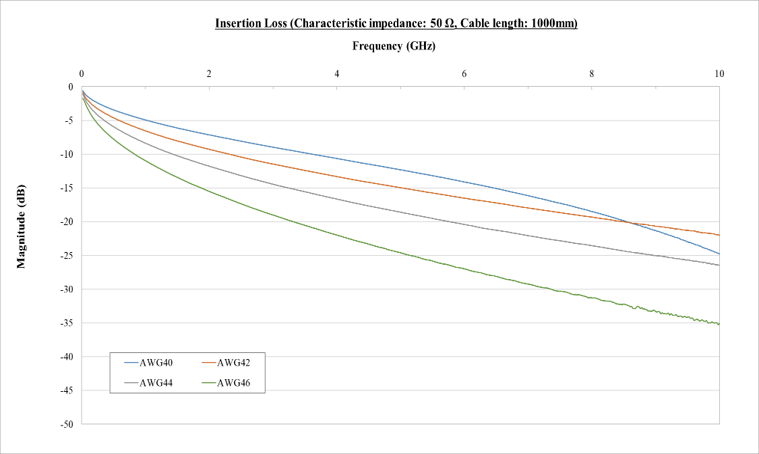高速ケーブルアッセンブリの主な損失
Insertion Loss, Return Loss and VSWR are key performance indicators of High Speed Twinaxial and Micro-Coaxial Cable Assemblies. A high performance micro-coaxial cable results in excellent signal integrity and reduced losses in high speed applications. At I-PEX we take pride to offer the high performance CABLINE micro-coaxial and twinaxial cable assemblies which are built by using automated assembly processes to ensure consistent high quality and low losses in each of the finished product.
Insertion Loss can be simply put as the amount of high frequency signal lost as heat in coaxial medium from transmitting to the receiving side. A thinner center conductor results in higher Insertion loss, similarly a longer coaxial cable also results in higher insertion loss. Insertion losses in coaxial cables are also increased with the increase in the overall cable length. Insertion Loss also increases with the higher frequencies while keeping the size of center conductor the same, due to Skin Effect. Skin effect is a phenomanon where most of high frequency AC signals crowd towards the surface of conducting material and efective cross sectional area of center conductor is reduced, thereby increasing the signal losses.

Insertion loss performance of various sizes micro-coaxial cables is shown in the Graph below for reference. Also, in general, a micro-coaxial cable offers a larger cross-sectional area of the center conductor to the electric fields as compared to FPC/FFC, keeping the impedance matched to the same value for both types, which minimizes the the insertion loss for micro-coaxial cables.

Return Loss is the signal loss due to reflections from either transmitting and receiving side of coaxial medium. These reflections are caused by the impedance mismatch of all the components of coaxial medium including the connectors, cables and any of the interposer PCBs in the assembly. Like Insertion Loss, Return Loss also increases typically with the higher frequencies but does not change significantly with the length of the coaxial cables. Uniform and matched impedance of complete cable assembly result in low Return Losses.
The signal reflections due to impedance mismatch also result in signal attenuation and result in standing waves all across the coaxial cable. This phenomenon is called Voltage Standing Wave Ratio. VSWR is an important performance parameter of high frequency interconnect mediums, VSWR if high, can lead to significant signal losses resulting in data loss.
It is important to select the right size and length of coaxial cable harness to keep the insertion loss low. Also, it is critical to cut, strip, prepare and terminate the coaxial cables precisely in assembly harness to closely match the impedance of all components and minimize the Return Loss and VSWR in medium.
Additionally, the outer conductor of both micro-coaxial and twinaxial cables works as an electromagnetic shield so the electrical signal transmitted on the center conductor is less susceptible to electromagnetic waves (electromagnetic noise) from the outside. In addition, the shielding effect of the outer conductor also helps to reduce crosstalk between signal lines.
Contents
- 1) What is a Micro-coaxial Cable Harness and why do you need it?
- 2) What is a Twinaxial Cable Harness and why do you need it?
- 3) What is the maximum operating frequency in your application?
- 4) What is the available real estate for connector/ receptacle and plug assembly?
- 5) Is there a need to shield the high frequency or power signals in the harness?
- 6) What are the main losses in high speed cable assemblies? How can the losses be minimized in my Harness Assemblies?
- 7) What are the bend, flex and twist requirements of the harness?
- 8) What is the required pin out of harness assemblies?
- 9) What is the required jacketing and bundling type on harness?
- 10) What are the typical high speed protocols supported by these harnesses?
- 11) How is a Micro-coaxial Cable Harness prepared and how many types of cables can be supported?
挿入損失、リターンロス、VSWRは、高速Twinaxialおよび細線同軸ケーブルアッセンブリでの重要な性能指標です。高性能な細線同軸ケーブルは、高速アプリケーションにおいて優れたシグナルインテグリティと損失の低減をもたらします。I-PEXでは、高性能なCABLINE細線同軸およびTwinaxialケーブルアッセンブリを提供することに誇りを持っています。自動化されたアッセンブリプロセスを使用して構築し、完成品の各々で一貫した高品質・低損失を保証します。
挿入損失とは、簡単に言えば、送信側から受信側へ同軸媒体中で熱として失われる高周波信号の量です。中心導体が細いほど挿入損失は大きくなり、同様に同軸ケーブルが長いほど挿入損失は大きくなります。同軸ケーブルの挿入損失は、ケーブル全長が長くなるにつれて増加します。また、中心導体のサイズが同じであっても、周波数が高くなると表皮効果により挿入損失が増加します。表皮効果とは、高周波の交流信号の多くが導体表面に集まり、中心導体の有効断面積が減少することで、信号損失が増加する現象です。
記事:細線同軸ハーネスジャンパー接続と低伝送損失基板接続の伝送優位性比較

|

|
参考までに、各種サイズの細線同軸ケーブルの挿入損失性能をグラフに示します。一般的に、細線同軸ケーブルはFPC/FFCに比べて中心導体の電界に対する断面積が大きく、インピーダンスを同じ値に保つことができるため、細線同軸ケーブルの挿入損失を最小限に抑えることができます。

リターンロスとは、同軸媒体の送信側と受信側のどちらかからの反射による信号損失のことです。これらの反射は、コネクタ、ケーブル、アッセンブリ内のインターポーザーPCBなど、同軸媒体のすべてのコンポーネントのインピーダンス不整合によって引き起こされます。挿入損失と同様に、反射損失も一般的に周波数が高くなるにつれて増加しますが、同軸ケーブルの長さによって大きく変化することはありません。ケーブルアッセンブリのインピーダンスが均一で整合されていれば、リターン・ロスは低くなります。
インピーダンスのミスマッチによる信号の反射も信号の減衰を招き、同軸ケーブル全体に定在波が発生します。この現象は電圧定在波比と呼ばれます。VSWRは、高周波相互接続媒体の重要な性能パラメータであり、VSWRが高い場合、データ損失の原因となる重大な信号損失につながる可能性があります。
挿入損失を低く抑えるためには、適切なサイズと長さの同軸ケーブルハーネスを選択することが重要です。また、すべてのコンポーネントのインピーダンスを密接に一致させ、媒体のリターン・ロスおよびVSWRを最小限に抑えるために、アッセンブリハーネス内で同軸ケーブルを正確に切断、ストリップ、取り外し、端末処理することが重要です。
また、細線同軸ケーブル、Twinaxケーブルともに、外部導体が電磁シールドとして機能するため、中心導体で伝送される電気信号は外部からの電磁波(電磁ノイズ)の影響を受けにくくなります。また、外部導体のシールド効果により、信号線間のクロストークを低減する効果もあります。
